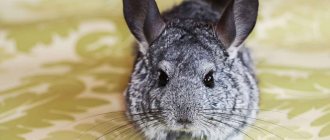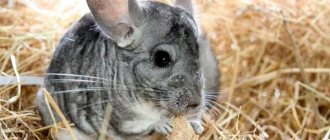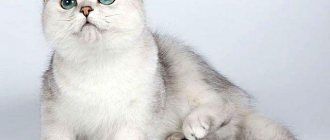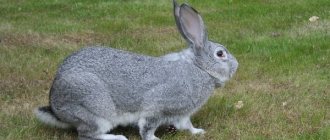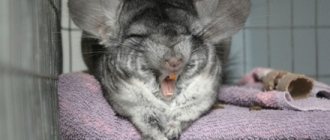The Persian chinchilla is a beautiful, stately cat with a short muzzle, expressive emerald eyes and a luxurious, elegant fur coat. Her exquisite appearance and aristocratic manners deserve the highest praise and become a source of pride for her owners.
And if you decide to buy a Persian chinchilla, you need to familiarize yourself with the characteristics of the breed in advance and ask how to care for these cats.
Brief history of the breed
Persian chinchillas appeared in England in the 80s of the 19th century. It is assumed that individuals with smoky and silver marbled colors were used to breed cats of this breed. There is also an opinion that in order to lighten the tone of the coat in the initial stages, the blood of the smoky British was infused into the Persian chinchillas. And a little later, individuals with a golden color appeared.
The popularization of the breed was facilitated by the fact that the docile and beautiful chinchillas attracted the attention of the granddaughter of the Queen of England, Princess Victoria. From the moment these cats settled at the palace, the British nobility became interested in them. Later, the breed spread throughout the world and is now actively bred on all continents.
Interesting Facts
During the existence of the Persian chinchilla, a lot of interesting things happened to it:
- The breed was named after South American rodents. But the color of cats is completely opposite to the color of chinchillas. Unlike rodents, their fur is light at the base and dark at the tips.
- The first standard chinchilla Persian named Silver Lamb Queens made a splash at the 1885 London Exhibition at the Crystal Palace. And his stuffed animal is still on display in the British Museum of Natural History.
- Persian chinchillas are very photogenic. Therefore, they can often be seen on the covers of publications for animal lovers.
- A chinchilla named Solomon has become a real screen star. He starred in the James Bond film “You Only Live Twice” as the pet of the leader of the secret organization “Spectre” Blofeld.
Breed description, standards, appearance
Persian chinchillas are compact, proportionally built cats with wide bones, a flattened nose and large, expressive eyes. At one time in the United States, attempts were made to assign them the status of a separate breed. But these cats are still considered a variety of Persians and must meet their standards.
Dimensions and weight
Chinchilla Persians are large animals with pronounced sexual dimorphism. A cat of this breed weighs 4-4.5 kg. The weight of a cat can reach 7-8 kg.
Anatomical characteristics
According to the CFA standard, a typical Persian chinchilla cat must meet the following parameters:
- The head is massive, round, with full cheeks, a flattened muzzle, a convex forehead, wide powerful jaws, a strong chin and a short upturned nose.
- The ears are small, tilted forward, set low and wide, with rounded tips and rich feathering.
- The eyes are green, expressive, round. They have a wide and even stance.
- The body is compact, squat, with a short neck, broad chest, well-developed muscles and a thick, straight tail that does not rise above the line of the back.
- The limbs are short, strong, smooth, with compact rounded paws and overgrown interdigital space.
Color and coat type
The body of the Chinchilla Persian is covered with fine, long, silky hair with a natural shine and developed decorative hair. A cat of this breed must have thick “pants”, rich feathering on the tail and a chic “frill” that smoothly flows into a train between the front legs.
Chinchilla Persians are characterized by a special color in which the roots of the hairs are pigmented white and the tips are dark. These cats are:
- silver;
- golden;
- tortoiseshells;
- lilac;
- chocolate;
- black.
The most popular is the Persian silver chinchilla. A cat of this color has a thick, boiling white undercoat and dark tips of a cool shade that resembles silver plating.
Possible breed defects
Defects for which a Persian chinchilla is subject to disqualification:
- white markings in the shape of stars or medallions;
- creases on the tail;
- polydactyly;
- back deformities;
- strabismus;
- asymmetry of the head and muzzle.
Health
In general, chinchilla cats can boast of good health. However, some hereditary diseases have not escaped them.
See also: American Shorthair cat
Polycystic kidney disease. Unfortunately, the disease is almost invisible in the early stages. In the later period of the disease, the animal’s abdomen increases in size and pain occurs.
Hypertrophied cardiomyopathy. Ultrasound will help identify the disease. The first symptoms are fatigue and shortness of breath.
Retinal atrophy. The eyes of a chinchilla are a kind of “Achilles heel” of the animal. Increased tear production and lack of regular care together can lead to complete blindness of the pet. Extremely dilated pupils and an unnatural shine in the eyes indicate that it is time to consult a veterinarian.
With proper care, the average life expectancy of chinchilla cats is twelve to fifteen years.
Character and temperament
Although chinchilla Persians give the impression of being lazy and headstrong animals, they have an easy-going and friendly disposition. Obedient and affectionate cats quickly get used to their owners and never cause any inconvenience. Inquisitive Persian chinchillas need to communicate with people and with a lack of attention they become apathetic or nervous.
Chinchilla Persians have a highly developed sense of self-esteem. Representatives of the breed do not accept violent expressions of emotions. Persian chinchillas calmly tolerate loneliness and do not bother their owners with annoying demands for attention.
The calm nature of cats of this breed allows them to easily find a common language with children of different ages. Chinchilla Persians never offend children and enjoy playing with older children.
Perhaps due to their natural aristocracy, cats of this breed feel superior to other pets. But it does not prevent them from getting along without problems with other animals that grew up with them. If the owners of an adult chinchilla decide to get a puppy or kitten, then there is a high probability that the cat will not accept it.
Breeding
Breeding chinchillas in Russia is accompanied by certain difficulties. Due to the difficulties in caring for the coat and maintaining color, there are few specialized nurseries.
Britons of silver or golden color can participate in mating, but choosing a pair for your pet is quite difficult.
If a partner is found, prepare your cat (or cat) for mating. Check with your veterinarian to make sure both animals are healthy. Perform deworming procedure. These measures will minimize the risk of sick or non-standard offspring.
How to choose the right kitten
Chinchilla Persians are not very rare, so the search for a kitten usually does not take much time. To become the owner of a healthy animal, it is recommended to purchase it from officially registered nurseries. When choosing a Persian chinchilla kitten, it is advisable to pay attention to the following factors:
- availability of metrics and veterinary passport;
- health status;
- conditions of detention;
- compliance with the breed standard;
- behavioral features.
On a note. A healthy kitten should be active and moderately inquisitive. If a small chinchilla is hiding and avoiding contact, it is better to pay attention to another candidate for pets.
Kitten care
Responsible breeders send chinchilla Persians to new homes no earlier than the kittens are 3 months old. By this age, children will have grown up and become stronger, will have received all preventive vaccinations and will have mastered basic self-care skills.
To make the process of adaptation to new conditions easy, it is recommended to ask the breeder for something with the smell of the native “nest”. And to prevent the Persian chinchilla kitten from getting injured, all potentially dangerous objects are removed from it in advance: electrical wires, medicines, ornamental plants, detergents and small fragile trinkets.
Price
In Russia, few specialize in this breed. In total, no more than six breeders are engaged in chinchilla cats. Those who have decided to purchase a kitten of such a wonderful breed should know that representatives of its price category occupy the average.
Purebred specimens, which can subsequently be presented at exhibitions and used in breeding, will cost future owners no less than 70 thousand rubles.
There is also a cheaper category of chinchilla kittens, which are estimated at 30 thousand. As a rule, such specimens of the breed, from the point of view of experts, have some kind of flaw, and they are not intended for breeding and showing.
Care and maintenance
Persian chinchillas easily adapt to any conditions. Therefore, they can be kept both in city apartments and in private cottages. Due to the special structure of their muzzle, chinchilla Persians need regular eye care. And the fluffy fur of these cats requires careful combing.
Otherwise, caring for Persian chinchillas is no different from caring for representatives of other shaggy breeds.
To keep cats looking neat, they are regularly subjected to simple hygiene procedures:
- The eyes of chinchilla Persians are wiped daily with a clean cloth soaked in boiled water, furatsilin solution or herbal decoction.
- Cats' claws are carefully trimmed with a nail clipper as they grow. To avoid touching blood vessels, only the transparent ends can be removed.
- The ears of Persian chinchillas are regularly inspected for any unusual discharge and gently wiped with a cotton pad soaked in ethanol-free lotion.
- The teeth of representatives of the breed are cleaned several times a week with a non-foaming paste, which is applied to a silicone attachment or a soft brush.
- The luxurious fur of Persian chinchillas is prone to matting. Therefore, in normal times it is combed several times a week, and during the molting period - daily. First, the cat's hair is treated with a comb with sparse teeth, and then with a brush with natural bristles. Tangled hair is carefully sorted out with your fingers or cut with scissors. Chinchilla Persians are bathed 3-4 times a year using shampoos for long-haired breeds.
Diseases
Following basic hygiene rules will reduce the risk of your pet contracting some dangerous diseases. When you come from the street, wash your hands immediately. Do not approach the cat in outerwear. The same applies to shoes: they can easily bring pathogens from the street. First of all, this applies to cats that have not yet been vaccinated.
A peculiarity of Persians is snoring during sleep. This is a feature of the body associated with congenital deformation of the nasal septum, so do not panic.
- Eye infections occur frequently in Persians. The treatment method is chosen by the veterinarian: in some cases medication is sufficient, in others only surgery will help.
- Polycystic kidney disease is the formation of cysts on the organ. Causes kidney failure. Maintenance therapy is recommended.
- Gingivitis and periodontitis are also quite common. If the disease is advanced, only tooth extraction will help.
- The special structure of the nasal passages leads to frequent colds. The cat should be protected from hypothermia: do not allow it to sit in a draft, dry its fur with a hairdryer after bathing, do not feed food from the refrigerator, and do not walk in bad weather.
- Hypertrophic cardiomyopathy is a thickening of the heart muscle. The cat begins to get tired quickly, cough, breathe heavily and moves little. It is impossible to cure the disease, but drug maintenance therapy can significantly alleviate the condition and prolong life.
- Dermatitis is characterized by the appearance of brown discharge around the nose and eyes. The hair in these areas falls out, the skin turns red and swells, which is why the cat experiences discomfort and constantly tries to scratch this area. It often spreads to the ears. Occurs mainly in young animals. Medicines can achieve remission, but without proper control the disease develops again.
Feeding the cat
Due to the fact that the luxurious coat of Persian chinchillas gets very dirty while eating, many breeders recommend giving these cats commercial premium or super premium dry food. When choosing drying products, it is important to pay attention to the expiration dates and composition of the assortment presented in the store. The food for Persian chinchillas should contain all the necessary vitamins and minerals. Cats of this breed eat well:
- Bosch;
- Royal Canin;
- Grandorf;
- Brit Care;
- Hills.
In contrast to those who recommend feeding chinchilla Persians with industrial food, there are also those who prefer to give their pets natural food. In this case, the cat's diet should include a sufficient amount of raw lean meat, which can occasionally be replaced with offal and ocean fish. Also, the menu of representatives of the breed should be diversified with cereals, vegetables, sour milk and quail eggs.
On a note. Persian chinchillas are very clean and often lick their coats. Therefore, it is recommended that they are regularly given a special paste to dissolve hairballs in the stomach.
In order not to undermine the health of chinchilla Persians with improper nutrition, river fish, fatty meat, confectionery, onions, potatoes, exotic fruits, sausages, canned food, pickles, smoked meats and any food from the owner’s table are completely removed from their diet.
Proper nutrition
When composing the diet of Persian chinchillas, you should remember about their predisposition to obesity and kidney failure. The animal must receive food in doses. It is better not to give him fatty foods and food from your table. The less active a pet’s lifestyle is, the fewer calories should be in its diet. It is ideal if the basis of nutrition is boiled meat. It could be:
- lean beef;
- chicken;
- rabbit meat.
You can periodically offer offal to the animal. Boiled eggs, cabbage, pumpkin, and other vegetables are good additions to meat foods. A bone meal supplement may also be helpful. Animal proteins should make up 40% of the total diet.
Milk is offered to cats up to 4-5 months of age. Adult animals are often lactose intolerant, causing diarrhea. If your chinchilla loves dairy, you can offer her fresh kefir. It is recommended to supplement the diet with cottage cheese. It is better to give food in small portions 2-3 times a day; uneaten leftovers are removed after 30 minutes.
The animal should always have fresh boiled water freely available. If desired, you can feed Persian chinchillas with professional food from well-known manufacturers. It is not recommended to give cats cheap dry chips; they often cause indigestion, allergies and urolithiasis. You should not save on your pet’s health; its treatment will cost much more.
Education and physical activity
The mobility of Persian chinchillas directly depends on age. Kittens and young animals love to play and have no problem finding entertainment. With age, the activity of chinchilla Persians decreases. And to prevent cats from becoming lazy, it is recommended to interest them in games with a laser pointer, balls or artificial mice.
Representatives of the breed are highly intelligent and easily remember something new. Chinchilla Persians are easily litter trained and quickly learn the rules of behavior in the house.
Consequences of suppressing the natural instincts of an animal
We should not forget that such procedures (castration and sterilization) are not only beneficial, but can also cause harm. It is known that after surgery aimed at suppressing the physiological needs of a feline, animals can gain extra pounds. Therefore, such a pet’s diet will need to be monitored for the rest of its life, in order to avoid serious health problems: obesity, shortness of breath, heart failure.
In this case, the answer to the question of how long castrated cats live at home will depend entirely on the person who competently builds the right diet for the pet with a minimum content of proteins and fats.
Pros and cons of the breed
Before making the final decision to purchase a Persian chinchilla, you need to analyze the advantages and disadvantages of the breed:
| pros | Minuses |
| Original appearance | Heavy shedding |
| Affectionate and flexible disposition | Snoring in your sleep |
| Cleanliness | Need for regular grooming |
Persian chinchillas are cute short-faced cats with an original shaggy coat. Thanks to their refined appearance and aristocratic manners, representatives of the breed will be excellent companions for those who are not afraid of the prospect of daily caring for their pet’s fur and regularly picking up a vacuum cleaner.
